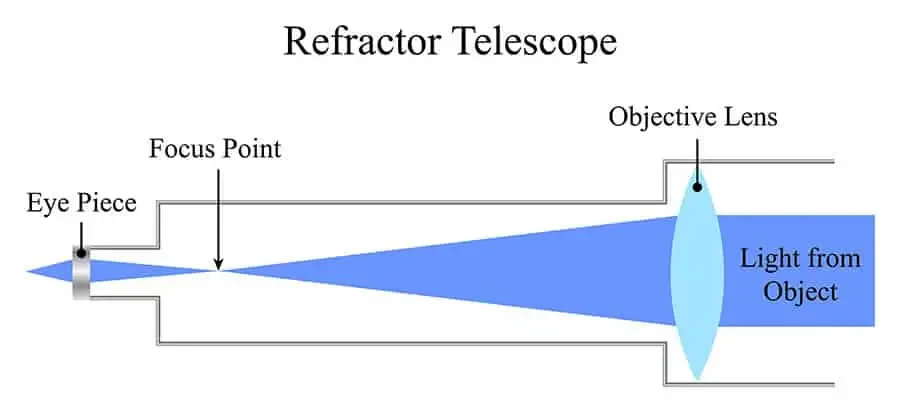Reflecting vs Refracting Telescopes – Which to Choose?
Reflecting and refracting telescopes, along with Catadioptric telescopes, are the three main telescope types. However, the majority of people mainly use reflectors and refractors when you’re just starting out.
So if you’re in the market looking for the most essential part of your astronomy rig, we’re here to help you decide which to choose. After this, you should know the difference between refracting telescopes and reflecting telescopes, which can help you know which one would be better for your needs.
Getting the right telescope isn’t easy, but fortunately with the internet, you can research beforehand and find out which model to opt for. Here’s my list of the top telescopes currently available if you’re in a rush. But, let’s take a look at the differences between reflectors and refractors.
At its simplest, the answer is that they use a different method of to produce an image. A refractor telescope relies on using an optical lens to gather enough light to focus the light through to the eyepiece. In comparison to this, a reflector telescope uses a primary mirror (objective) in combination with a secondary mirror (reflecting mirror).
A reflector telescope is largely made up of mirrors, and you’ll find the focuser and eyepiece on the top of the telescope tube. This is where refactor telescopes differ, as they are only made up of lenses, and you can find them at the back of the telescope tube.
Though they work differently to each other, they’re designed with the same purpose in mind – to gather and focus the light from the night sky above us. Typically, a refractor telescope will have a smaller size and aperture, which means that they gather less light, and therefore they are typically powerful.
The truth is that both telescopes have their advantages, and there are areas where they are similar too – optical quality isn’t always dictated by telescope type, for example. But, there are advantages to opting for a refractor over a reflector too. Let’s look at both of them a little closer to find out more.
Reflecting telescopes are sometimes referred to as ‘reflectors’. This is, basically, a type of telescope that is closely related to Newtonian telescope – it belongs to a larger group of catoptrics telescopes along with Cassegrain telescopes, Crossed Dragone telescopes, Gregorian telescopes, Wolter telescopes, and others.
Reflectors are ‘lens-less’ telescopes that utilize convex mirrors that reflect light. While lenses are best suited for ‘low-range’ observation, mirrors allow more light to pass through, which in turn makes Reflectors ideal tools for observations of the deep space.
Many amateur astrophotographers prefer the reflecting telescope, and there’s a few reasons why.
Depending on what type of mirror is used, a reflector will provide a different type of optical performance. The cheapest option (which most manufacturers rely on) is utilizing spherical mirrors. Now, spherical mirrors might be flimsiest, but they reflect light pretty reliably and nicely. However, the downside of this mirror type is that they tend to blur the image somewhat, rendering reflectors equipped with them virtually unusable for deep space observation.
Parabolic mirrors are typically made of superior quality in comparison to spherical mirrors – they gather more light and ‘reflect’ it back with more consistency. Sadly, most parabolic mirror models aren’t capable of dealing with problems of chromatic aberration (blurring).
The type of a mirror that is the least commonly used due to its sky-high price tag is the hyperbolic mirror. Even though they’re not so readily available and are pricey to the boot, this is the only type of mirror that can provide a clear, vivid image of distance space objects with ease.
Most reflectors feature the open-end design, which basically means that their mirrors are highly exposed to environmental ‘hazards’, such as humidity or dust particles. Under normal circumstances, the wind or smaller chunks of dust debris wouldn’t be able to damage the mirror per se, but they could destabilize and unbalance the telescope.
What this means is that the mirror won’t lose its original quality or in the worst-case scenario ‘break’, but its ‘edge’ will gradually get duller. In other words, this means that most reflectors lose their ability to gather and reflect white light – their efficiency will decrease over time.
This ‘flimsiness’ of reflectors is easily dealt with, though. All you need to do is regularly maintain them in terms of cleaning the mirrors thoroughly and keeping the telescope safely stored while you’re not using it.
They’re perfect for pretty much anything from observing the Moon, spotting distant planets, or even gazing at the deep space as far as their technical specs go. In a nutshell, they’re usually supplied with larger mirrors that can collect superior amounts of light in comparison to refractors; they typically suffer from minor chromatic aberrations, and what might be most important to some people, they don’t cost a fortune.
On the downside, optical quality of a reflector isn’t exemplary; they need a lot of maintenance, and they’re usually quite big and weigh a lot.
- They have more light gathering power, which means you’ll get increased magnifications and a greater ability to see distance objects.
- Having a long focal length is common with reflecting telescopes – many of the top NASA telescopes are reflectors, as they’re great for seeing celestial bodies.
- You don’t need to worry about chromatic aberration or color fringing with a reflecting telescope, as they use mirrors.
Refracting telescopes are sometimes called ‘dioptric telescopes’. Unlike their catoptrics counterparts, refractors they use lenses as objectives in order to form visible images. A typical layout of a refractor includes a lens located at its front side that is connected via a tube, and lastly ending with an eyepiece at its rear.

On one hand, refractors are unparalleled when it comes to spotting and observing anything but the deep space. They’re ideal for watching the stars, comets, satellites, and similar space objects, but the further you ‘go’, the worse the quality of their optical performance is.
While certain reflector models suffer from minor chromatic aberration, almost all (if not all) refractors can’t escape it. Basically, they collect less light, but they’re also supplied with lenses (instead of mirrors) that can’t retain their initial sharpness at certain points.
Just like the situation with reflectors is, there are means to counter the chromatic aberration phenomenon in refractors too; most people implement another lens, but other options exist too, such as increasing the value of the aperture; by using a field flattener, coma correctors, or by recalibrating the telescope (depending on which type of aberration is in question).
Refractors are generally a bit smaller and more compact in comparison to reflector telescopes; this means that you can set them up pretty much anywhere as long as the skies are clear. They offer more convenience in terms of transportation, but they’re also not as demanding as reflectors in terms of maintenance due to their (predominantly) closed-end design.
This type of design offers enhanced protection against environmental hazards while at the same time reducing the amount of effort needed to be put into the maintenance process itself.
On the flip side, lenses typically have a smaller diameter, which means that they can’t collect so much white light. This isn’t a problem in most cases, but it renders them unusable for deep-space observation as it, almost by default, results in one or even several types of chromatic aberrations.
Due to the fact that they offer more transportability and convenience, as well as due to the more expensive materials they’re built from, refractor telescopes are generally slightly more expensive.
- They tend to have a higher optical quality when compared to an equally priced reflecting telescope (though you sacrifice this for magnification).
- Refracting telescopes are much easier to set up then their reflector counterparts, which need collimation before you can use them.
- For a beginner friendly telescope, you can’t really go wrong with a refracting telescope, as they’re simple enough to use out of the box.
At the end of the day, you should take several factors into consideration before deciding which type of telescope is better for you. First and foremost, decide your budget; this will significantly narrow down your selection.
If you’re an amateur or a beginner who’s just starting out, reflectors are generally better due to their inexpensiveness. However, they can be more difficult to set up, whereas a refractor doesn’t require any alignment. This can be a benefit if you’re looking for the best telescope for immediate use.
All three telescope types offer very different benefits and present different obstacles that you’ll need to gap if you wish to utilize them in full. And the truth is that these telescope designs are ‘great’ before they are flawed, so you can’t make that much of a mistake whichever you choose.





